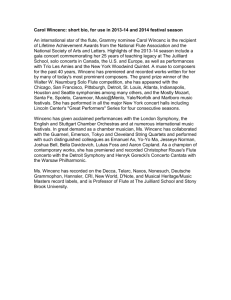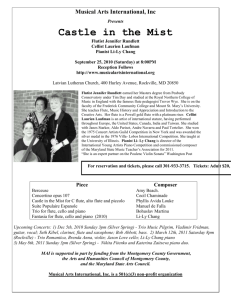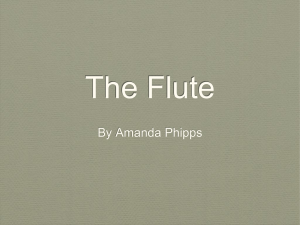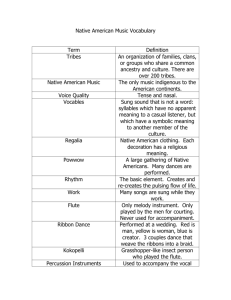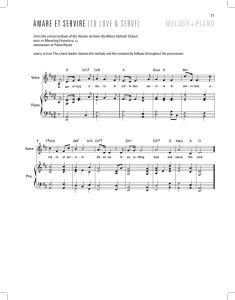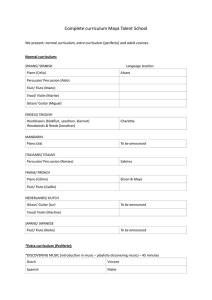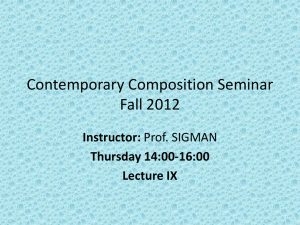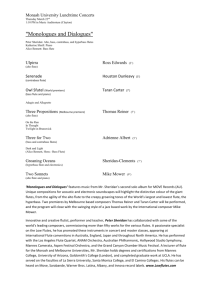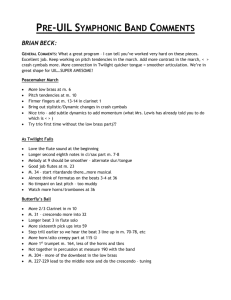SUNDERMAN CONSERVATORY OF MUSIC
advertisement
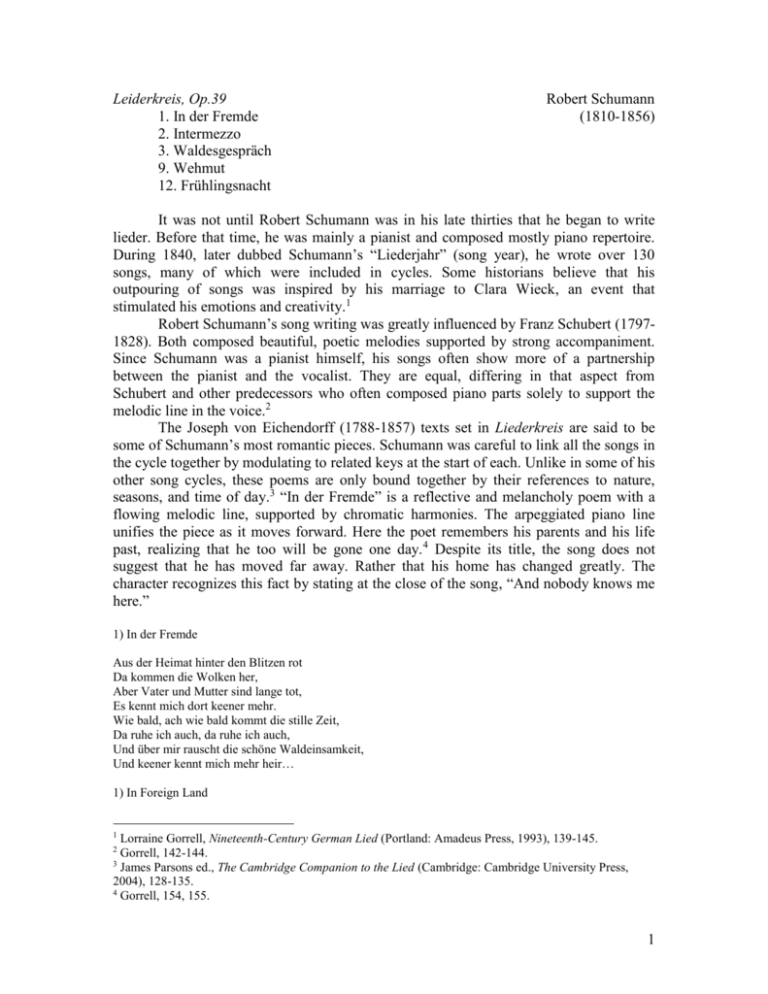
Leiderkreis, Op.39 1. In der Fremde 2. Intermezzo 3. Waldesgespräch 9. Wehmut 12. Frühlingsnacht Robert Schumann (1810-1856) It was not until Robert Schumann was in his late thirties that he began to write lieder. Before that time, he was mainly a pianist and composed mostly piano repertoire. During 1840, later dubbed Schumann’s “Liederjahr” (song year), he wrote over 130 songs, many of which were included in cycles. Some historians believe that his outpouring of songs was inspired by his marriage to Clara Wieck, an event that stimulated his emotions and creativity.1 Robert Schumann’s song writing was greatly influenced by Franz Schubert (17971828). Both composed beautiful, poetic melodies supported by strong accompaniment. Since Schumann was a pianist himself, his songs often show more of a partnership between the pianist and the vocalist. They are equal, differing in that aspect from Schubert and other predecessors who often composed piano parts solely to support the melodic line in the voice.2 The Joseph von Eichendorff (1788-1857) texts set in Liederkreis are said to be some of Schumann’s most romantic pieces. Schumann was careful to link all the songs in the cycle together by modulating to related keys at the start of each. Unlike in some of his other song cycles, these poems are only bound together by their references to nature, seasons, and time of day.3 “In der Fremde” is a reflective and melancholy poem with a flowing melodic line, supported by chromatic harmonies. The arpeggiated piano line unifies the piece as it moves forward. Here the poet remembers his parents and his life past, realizing that he too will be gone one day. 4 Despite its title, the song does not suggest that he has moved far away. Rather that his home has changed greatly. The character recognizes this fact by stating at the close of the song, “And nobody knows me here.” 1) In der Fremde Aus der Heimat hinter den Blitzen rot Da kommen die Wolken her, Aber Vater und Mutter sind lange tot, Es kennt mich dort keener mehr. Wie bald, ach wie bald kommt die stille Zeit, Da ruhe ich auch, da ruhe ich auch, Und über mir rauscht die schöne Waldeinsamkeit, Und keener kennt mich mehr heir… 1) In Foreign Land 1 Lorraine Gorrell, Nineteenth-Century German Lied (Portland: Amadeus Press, 1993), 139-145. Gorrell, 142-144. 3 James Parsons ed., The Cambridge Companion to the Lied (Cambridge: Cambridge University Press, 2004), 128-135. 4 Gorrell, 154, 155. 2 1 From my homeland, in the wake of red lightning The clouds are drifting here, But my father and mother are long dead, No one knows me there anymore. How soon, oh how soon, will the quietude come, When I too will rest, when I too will rest, And above me rustles the lovely solitude of the woods, And no one knows me here anymore… Rhythmic interest in “Intermezzo” hails from the syncopation heard chiefly in the piano. The song written in ABA form has a very modest melody, supported by chordal figures which often echo the vocalist. The piano also plays a solo countermelody throughout the piece separate from the rest of the accompaniment which continues through the end. The poem rises to excitement by its midpoint, describing a heart that is “soaring” and “hurriedly flying.” The music accelerates and builds to reflect this.5 2) Intermezzo Dein Bildnis wunderselig Hab’ ich im Herzengrund, Das sieht so frisch und fröhlich Mich an zu jeder Stund’! Mein Herz still in sich singet Ein altes, schönes Leid, Das in die Luft sich schwinget Und zu dir eilig zieht. 2) Intermezzo Your image wondrously lovely I carry deep in my heart, It looks so fresh and cheerful Upon me all the time. My heart sings silently within itself An old, beautiful tune, That soars into the air And hurriedly flies to you. “Waldesgespräch” is often considered the boldest song in the cycle, quite different from the first two songs. The poem is a conversation between a man and a beautiful woman in the woods. This piece is unified by the sounds of hunting horns heard throughout although there are two distinct textures, an abrupt and trembling accompaniment representing the man, contrasting the flowing arpeggios supporting the dialogue of the woman. As the conversation continues, the man realizes that the woman is actually the sorceress Lorelei, a spirit who sings siren songs from the cliffs above the Rhine River, summoning ships toward the rocks. The arpeggios symbolize the spell she casts. At this discovery, the man begins to shout with a frightened tone, supported by an 5 Gorrell, 155. 2 abrupt change in the accompaniment. Only at the close of the song does Lorelei’s melody change from the beautiful flowing melody as she tells the man that he will never leave the forest.6 3) Waldesgespräch “Es ist schon spät, es is schon kalt, Was reit’st du einsam durch den Wald? Der Wald ist lang, du bist allein, Du schöne Braut! ich führ’ dich heim!“ “Gross ist der Männer Trug und List, Vor Schmerz mein Herz gebrochen ist, Wohl irrt das Waldhorn her und hin, Oh flieh’! o flieh’! du weisst nicht, wer ich bin.“ “So reich geschmückt ist Ross und Weib, So wunderschön, so wunderschönder junge Leib; Jetzt kenn’ ich dich, Gott steh’mir bei! Du bist die Hexe Loreley!“ “Du kennst mich wohl, von hohem Stein Schaut still mein Schloss tief in den Rhein. Es ist schon spät, es ist schon kalt, Kommst nimmermehr aus diesem Wald.“ 3) Dialogue in the Woods “It is already late, it is already cold, Why do you ride lonely through the woods? The wood is large, you are alone, You lovely bride! I guide you home.” “Great is men’s cunning and deceit, With sorrow my heart has been broken, The hunter’s horn sounds here and yon, Oh flee! Oh flee! you know not who I am.” “So richly adorned are steed and woman, So wondrously fair the young body; I know you now, my God help me! You are the sorceress Lorelei!” “You know me well, from the rock on high My castle looks silently into the Rhine. It is already late, it is already cold, Nevermore will you leave this wood.” “Wehmut” is another poem dealing with sadness and melancholy. The rubato tempo runs throughout the piece, which the vocalist may interpret to make as emotional as desired. Schumann sets this poem with a rather simple, hymn-like accompaniment. He also doubles the vocal melody with the right hand in the piano. It is not until the vocalist has finished that the accompaniment changes and becomes more chromatic.7 9) Wehmut 6 7 Carol Kimball, Song: A Guide to Style and Literature (Redmond: Pst. Inc., 1996), 91-92. Gorrell, 157. 3 Ich kann wohl manchmal singen, Als ob ich fröhlich sei; Doch heimlich Tränen dringen, Da wird das Herz mir frei. Es lassen Nachtigallen, Spielt draussen Frühlingsluft, Der sehnsucht Lied erschallen Aus ihres Kerkers Gruft. Da lauschen alle Harzen, Und alles ist erfreut, Doch keiner fühlt die Schmerzen, Im Lied das tiefe Leid. 9) Melancholy Sometimes I may be singing As if I were full of joy, But secretly tears are flowing, And then my heart feels free. The nightingales will sing, When spring breezes play outside, Their melody of yearning Out of their prison’s tomb. Then all the hearts are listening, And everyone is glad, But none can feel the sorrows, The bitter grief in the song. “Frühlingsnacht” is filled with a great deal of energy, given mostly by the repetitive sixteenth notes in the piano. The piece continues to build from beginning and concludes with the joyous exclamation “She is yours!” Schumann may have chosen this piece to conclude his cycles because of his rejoicing love for Clara. Unlike other cycles, Liederkreis, op. 39 does not utilize material from the beginning movements to close the piece. Schumann chose to unite the song cycle with his choice of tonal centers. Schumann begins the song cycle in a minor key and concludes in the parallel major key. 8 12) Frühlingsnacht Über’m Garten durch die Lüfte Hört’ ich Wandervögel zieh’n. Das bedeutet Frühlingsdüfte, Unten fängt’s schon an zu blühn. Jauchzen möchte weinen, Ist mir’s doch, als könnt’s nicht sein! Alte Wunder wieder scheinen Mit dem Mondesglanz herein. Und der Mond, die Sterne sagen’s, Und im Traume rauscht’s der Hain, Und die Nachtigallen schlagen’s: “Sie ist deine, sie ist dein!” 8 Gorrell, 158,159. 4 12) Spring Night Above the garden through the breezes I heard birds of passage fly. That means scents of spring are coming, On the grounds the blossoms start. I would like to shout for you, to weep, It seems to me it cannot be! Ancient miracles shine again With the moonlight in my room. And the moon, the stars proclaim it, And the woods rustle in a dream, And the nightingales are singing: “She is yours, she is your own!” 9 Serenade (1803) Ludwig van Beethoven I. Entrata – Allegro (1770-1827) IV. Andante con Variazioni – Variations I-III and Coda V. Allegro scherzando e vivace VI. Adagio VII. Allegro vivace e disinvolto Much has already been said about Beethoven’s life. When Serenade was composed, Beethoven was going through very troubling times – around 1800, he began to lose his hearing. Yet, despite this crippling depression, or perhaps because he needed to keep pushing forward, this was also a time of great creativity for Beethoven, for this was when he wrote his only opera, his ground-breaking Eroica symphony, and the Waldstein sonata.10 With Beethoven composing all of these larger works, it is a wonder that he had the time to compose for a small chamber group. As Beethoven’s second “Serenade,” this work was a bit of an anomaly at the time because outdoor night-pieces were beginning to go out of style – it was basically background music to be played at a party.11 However, to Beethoven it is homage to his former teachers – Franz Josef Haydn and Antonio Salieri. About his writing, the composer stated, “When a beginner, I should have perpetuated the most egregious follies in composition but for Papa Haydn’s advice.” Therefore, this piece displays Beethoven’s development as a composer and reflects the styles of the two men who influenced him the most. Written in D Major, Serenade opens with a movement full of life. Marked by arpeggiated figures stated in the solo flute beginning, the entire movement has a playful quality with the flute and fortepiano often trading rhythms and pitches to form one complete line. The theme and variations opens with a slow andante, then immediately changes mood with staccato statements and sweeping scalar passages in the flute part of the first variation. Variation II changes to a triplet feel, with the fortepiano taking the 9 English translations from Edith Braun and Waldo Lyman eds., Liederkreis Op. 39 (New York: International Music Co., 1954). 10 Paraphrased from Kerman, Joseph and Alan Tyson. “Beethoven, Ludwig van.” Grove Music Online. http://www.grovemusic.com. 11 Thank you to Dr. Bowers for providing this information. 5 lead and the flute remaining as mere ornamentation. The same feel applies to Variation III, where the fortepiano does most of the work and the flute merely floats above, playing octaves and ornamentations of the main melody. The main melody returns in the coda, effectively creating closure for the variations. In contrast to the variations, the allegro scherzando reaches into the upper range of the flute and contains a great deal of syncopation, which is used to create a sense of harmonic tension. A slow adagio leads directly into the finale of the piece – the allegro vivace. With its bouncy melody and soaring arpeggios, the finale is full of excitement. There is a great deal of interplay between the flute line and the fortepiano part, and the two must consistently work together to convey the overall style and feeling of the piece. A cadenza and the final rollicking scalar statements in the flute end the piece with a flourish. So complete is the interaction between the various parts that James Galway, celebrated flutist, has said of the work, “Considered as an experiment in classical ensemble, Beethoven’s Serenade is a most happy work, perhaps lacking polish and consistently lofty thematic development, but always proving a most idiomatic example of part-writing.”12 Fêtes galantes, série I 1. En Sourdine 2. Fantoches 3. Clair de lune Claude Debussy (1862-1918) Claude Debussy was very skilled at creating an overwhelming sense of mood within his music. When composing mélodies he often chose texts depicting a certain scene which he then reflected in his music. Debussy is considered to be the most capable French composer at combining poetry with music.13 Debussy believed, “Music and poetry are the only two arts that move in space.”14 All aspects of his compositions are subject to the texts, especially tonal color, tempo, and dynamics. Most often he set music to poems of his contemporaries, most notably Paul Verlaine (1844-1896). Debussy enjoyed setting Verlaine texts because their references to musical elements made them especially suitable.15 Verlaine’s collection Fête galantes were inspired by the paintings of Watteau, which depicted poetic scenes of French culture and taste. “En Sourdine” and “Clair de lune” share a similar mood credited to Debussy’s use of the pentatonic scale.16 “En Sourdine” opens with a steady piano that begins repeating the same note before a gradual fall, creating a hypnotic effect which relieves any feelings of tension. This soft movement never rises above a dynamic of mezzo-forte, reflecting nature at dusk. These elements along with the pentatonic nature of the melody give the listener a calm feeling. Other elements in the melody and piano accompaniment contribute to the 12 Galway, James. James Galway: Sixty Years, Sixty Flute Masterpieces, Volume 4: In the Classical Parlor. New York: BMG Classics, 1999. BMG 09026-63436-2. CD. 13 Kimball, 184. 14 Debussy qtd. in Kimball, 184. 15 Kimball, 184-185. 16 Kimball, 188-190. 6 scene that Debussy sets, including the colored harmonies and triplet figures that imitate the rustling grass and breeze.17 Fêtes galantes, série I 1) En Sourdine Calmes dans le demi-jour Que les branches hautes font, Pénétrons bien notre amour De ce silence profond. Fondons nos âmes, nos cœurs Et nos sens extasiés, Parmis les vagues langueurs Des pins et des arbousiers. Fermes tes yeux à demi, Croise tes bras sur ton sein, Et de ton cœur endormi Chasse à jamais tout dessein. Laissons-nous persuader Au souffle berceur et doux, Qui vient à tes pieds rider Les ondes de gazon roux. Et quand, solennel, le soir Des chênes noirs tombera, Voix de notre désespoir, Le rossignol chantera. Courtly Outing, Part 1 1) Muted Calm in the half-light That the high branches make, Let us permeate our love With this profound silence. Let us melt together our souls, our hearts And our sense in ecstasy, Among the vague languors Of the pines and arbutus trees. Half close your eyes, Fold your arms on your breast, And from your sleeping heart Drive away all care forever. Let us be drawn By the gentle, rocking wind, 17 Arthur Wenk, Claude Debussy and the Poets (Berkeley: University of California Press, 1976), 35-42. 7 That comes to ripple at your feet The waves of russet grass. And when solemnly the evening Shall fall from the dark oaks, That voice of our despair, The nightingale will sing. In “Fantoches,” Verlaine outlines stage directions for the Italian silent drama and its cast of commedia dell’arte players, including the “docteur bolonais,” a pirate and a maiden as well as Scaramouche and Pulcinella, whose names begin the piece. Debussy takes time to outline his characters, changing the accompaniment in each stanza as each character is profiled. Debussy even takes time to point out the nightingale who cries at the close of the poem by giving a high rise in the melodic line, accompanied by a trill in the piano.18 Stylistically set apart from the other songs in this set, this song combines phrases of a short staccato melody with long legato lines and a faster tempo. The melody outlines chords most of the time when it is not imitating the chromaticisim often set up by the piano accompaniment. 2) Fantoches Scaramouche et Pulcinella Qu’un mauvais dessein rassembla Gesticulent, noirs sous la lune. Cependant l’excellent docteur Bolonais cueille avec lenteur Des simples parmi l’herbe brune. Lors sa fille, piquant minois, Sous la charmille, en tapinois, Se glisse demi-nue en quête De son beau pirate espanol, Dont un amoureux rossignol Clame la détresse à tue-tête. 2) Marionettes Scaramouche and Pulcinella Whom some evil scheme brought together Gesticulate, black figures beneath the moon. Meanwhile, the fine doctor From Bologna slowly gathers Simples among the dark grass. Then his daughter, that saucy looker, Beneath the bower slyly Slips in, half nude, in quest Of her handsome Spanish pirate, 18 Wenk, 227-231. 8 Whose distress an amorous nightingale Proclaims in full voice. During this time, composers often used non-traditional scale patterns new to Western music, trying to compose music that was different and unique. “Clair de lune” presents a variety of conflicting moods, specifically focusing on the relationship between sadness and beauty written with melodic emphasis on a pentatonic scale pattern. One of the most famous lines written by Verlaine opens the piece: “Votre âme est un paysage choisi,” meaning “your soul is a choice landscape.”19 Verlaine and Debussy both try to convey a sense that life can be unexpected. One can disguise oneself either to mask or reveal happiness. Debussy reflects these changes in mood throughout his song, all the while with the backdrop of the moonlight. When the text is happy, the melody drifts to a major mode. If moving toward the minor for the more melancholy texts. Since much of the melody is based on a pentatonic scale, the vocal line again seems very unpredictable here, representing the unpredictability of life.20 3) Clair de lune Votre âme est un paysage choisi Que vont charmants masques et bergamasques Jouant du luth et dansant et quasi Tristes sous leurs déguisements fantasques. Tout en chantant sur le mode mineur L’amour vainqueur et la vie opportune, Ils n’ont pas l’air de croire à leur bonheur Et leur chanson se mêle au clair de lune, Au calme clair de lune triste et beau, Qui fait rêver les oiseaux dans les arbres Et sangloter d’extase les jets d’eau, Les grands jets d’eau sveltes parmi les marbres. 3) Moonlight Your soul is a choice landscape Where charming maskers and bergamaskers go about Playing the lute and dancing and are almost Sad beneath their whimsical disguise. While singing in the minor of Love triumphant and the good life, They seems not to believe in their own happiness And their song is mixed and lost in the moonlight. In the calm moonlight, sad and beautiful, That makes the birds dream in the trees And the fountains sob in ecstasy, Those tall slender fountains among the statues21 19 Verlaine qtd. in James R. Briscoe ed., Songs of Claude Debussy; Volume II (Milwaukee: Hal Leonard Corporation, 1993). 20 Wenk, 24-29. 21 English translations from Briscoe. 9 Three Irish Folk Song Settings 1. The Salley Gardens 2. The Foggy Dew 3. She Moved Through the Fair John Corigliano (b. 1938) John Corigliano grew up in a very musical family, having a mother who played piano and a father who became the concertmaster of the New York Philharmonic. Corigliano had a creative imagination which gave him the will the write music. “I first started composing because of an incredible curiosity: can I make these sounds that I want to hear.”22 As a result, he wrote many pieces that combined genres, including concerto pieces for wind instrument and orchestra, and duets such as Three Irish Folk Song Settings.23 The vocal line in each of the three movements stays true to the folk melody. The interest comes from the flute part which performs its own independent melody line. At times it is supportive of the vocal line, although it is mainly its own contrasting entity. Marked by an atonal quality and sharp rhythms, the flute part is challenging. In “Down by the Sally Gardens,” the flute provides a sort of low ostinato peppered with quick runs that supports the lyric vocal part. In its solo passages, the flute is allowed to soar in its upper register, playing variations and ornamentations on the main melody. In the “The Foggy Dew,” the flute opens with a highly ornamented version of the melody. In this song, the challenge for the player is keeping the accompaniment light while still moving the piece along. This helps the vocal line to come through the high flute register. In the third song, the flute and voice must work together perfectly to effect the proper musical texture. Another challenge rises as each musician must bear in mind how their part fits together despite constantly changing time signatures. In addition, the meter changes even more for the flute as the hemiolas interspersed throughout pose considerable counting and subdividing challenges. 1) The Salley Gardens Down by the Salley gardens My love and I did meet. She passed the Salley Gardens With little snow white feet. She bid me take love easy As the leaves grow on the tree. But I being young and foolish With her did not agree. In a field by the river My love and I did stand. And on my leaning shoulder She laid her snow white hand. She bid me take life easy As the grass grows on the wiers, But I was young and foolish And now am full of tears. 22 23 Rorem qtd. in Ann McCutchan, The Muse That Sings (Oxford: Oxford University Press, 1999), 33. McCutchan, 33-36. 10 2) The Foggy Dew Adown the hill I went at morn A lovely maid I spied. her hair was bright as the dew That wets sweet Anners verdant side. “Now where go ye sweet maid?” said I. She raised her eyes of blue, And smiled and said, “The boy I’ll wed I’m to meet in the foggy dew!” Go hide your bloom, ye roses red And droop ye lilies rare, For you must pale for very shame Before a maid so fair! Say I, “Dear maid, will ye be my bride!” Beneath her eyes of blue She smiled and said, “The boy I’ll wed I’m to meet in the foggy dew.” A down the hill I went at morn Asinging I did go. Adown the hill I went at morn She answered soft and low, “Yes, I will be your own dear bride And I know that you’ll be true.” Then sighed in my arms and all her charms They were hidden in the foggy dew. 3) She Moved Through the Fair My young love said to me, “My mother won’t mind And my father won’t slight you for your lack of kine.” And she stepped away from me and this she did say, “It will not be long, love, ‘til our wedding day.” She stepp’d away from me and she went thro’ the fair, And fondly I watched her move here and move there, And then she went homeward with one star awake, As the swan in the evening moves over the lake. Last night she came to me, she came softly in So softly she came that her feet made no din, And she laid her hand on me and this she did say, “It will not be long, love, ‘til our wedding day.” -Pause- 11 Winter Spirits (1997) Katherine Hoover (b. 1937) Katherine Hoover was born in West Virginia, and studied at the Eastman School of Music where she received a Bachelor of Music in Music Theory and a Performance Certificate in Flute performance. She was a professor at the Manhattan School of Music and finished her Master’s studies in Music Theory while teaching. Her career as a conductor, composer, and flutist has led her to receive many honors and distinctions such as a National Endowment Composer’s Fellowship, receipt of an Academy of Arts and Letters Academy Award in Composition, and four prizes for her flute compositions entered in the National Flute Association’s Newly Published Music Competition. She currently resides in New York.24 Following the composition of Canyon Echoes (1991) for flute and guitar, and Kokopeli (1990) for solo flute, Winter Spirits continues Hoover’s tradition of incorporating Amerindian themes and ideas in her music. Here, she applies those ideas to yet another flute piece, evoking the spirit of a Native American flutist. Of the work, the composer states: There is a picture by the marvelous artist Maria Buchfink of a Native American flute player; from his flute rises a cloud of Kachinas and totem spirits. This piece has also risen from his notes, and it is indeed influenced by Native American music. The idea of the flute invoking beneficial spirits, be they Kachinas or any others, is a very natural one. Such spirits are an accepted and valued part of life in most of the world, and the flute has been used to honor and invite their presence for countless ages.25 Much of Winter Spirits is based on interpretation. With no “real” key or time signature, it is up to the flutist to interpret the beat, giving it a free feeling. The quick grace notes, trills, and complicated runs lend themselves to a sense of freedom for the flutist. It is the interpretation of these elements that gives the piece its Native American sound and provides the sense that it is being played in a cave in the heart of the New Mexico desert. “Con amores la mi madre” “Del cabello más sutil” “Chiquitita la novia” Fernando Obradors (1897-1945) After being taught piano by his mother as a child, Fernando Obradors taught himself harmony, composition and counterpoint. Although he wrote numerous symphonic works, he is most known for his Caciones clásicas españolas (Classic Paragraph paraphrased from Composer’s Bureau: Katherine Hoover. http://www.sainational.org/phil/composers/khoover.html (Accessed 20 September 2005). 25 From Hoover, Katherine. Kokopeli: Katherine Hoover Plays. Woodstock, NY: Parnassus, 2001 PACD 96031. 24 12 Spanish Songs).26 Obradors’s piano writing was more virtuositic than that of some of his contemporaries, allowing the voice to become totally engulfed within the accompaniment. He also included nationalist references within his melodies, composing lines that used different scalar modes and frequent note slurring.27 “Con amores, la mi madre,” is a lullaby with a simple melody accompanied by a moving bass line, reflecting the motion of a mother rocking her baby to sleep. This song has a very slow tempo allowing the emphasis to be given to the text, written in the fifteenth century by Juan Anchieta (1462-1523), the leading Spanish church composer for the royal court at the time.28 1) “Con amores, la mi madre” Con amores, la mi madre, Con amores me dormí; Así dormida soñaba Lo que el corazón velaba, Que el amor me consolaba Con más bien que merecí: Adormeció me el favor Que amor me dio con amor; Dio Descanso a mi dolor La fe con que le serví. Con amores, la mi madre, Con amores me dormí. 1) With love, my mother With love, my mother, With love I fell asleep; Thus asleep, I was dreaming That which my heart was hiding, That love was consoling me With more good than I deserved. The aid lulled me to sleep. What love gave me, with love, Put to bed my pain by The faith with which I served you. With love, my mother, With love I fell asleep. “Del cabello más sutil,” is set in a variation of strophic form, in which the text is set in verses to the same or similar melodic line. The poem itself is very romantic, due to the passionate melody and amorous text. The piano accompaniment below consists of a series of arpeggios, sounding similar to a harp, which may symbolize the flowing hair of the beloved.29 2) “Del cabello más sutil” 26 DiPalma & Walters eds., Anthology of Spanish Song (Milwaukee: Hal Leonard Corporation, 2003), xi. Graham Johnson, Spanish Songs (Chandos Records LTD. Colchester, 1994), 6. 28 DiPalma & Walters, xi. 29 Kimball, 421. 27 13 Del cabello más sutil Que tienes en tu trenzado He de hacer una cadena Para traerte a mi lado. Una alcarraza en tu casa, Chiquilla, quisiera ser, Para besarte en la boca, Cuando fueras a beber. 2) “Of the hair most delicate” Of the hair most delicate That you have in your braids, I have to make a chain To bring you to my side. A jug in your house, Darling, I would like to be, To kiss you on the mouth When you went to drink. This final piece is clearly the most technically challenging of the three. The introduction is extremely chromatic and proves to be quite a challenge considering its high range. Again, the accompaniment resembles a harp in this opening section. A short, dance-like piano interlude separates the first part of the song from the second. Although there are some rhythmic and melodic motives that link the interlude with the vocal line, the staccato material is very different compared to the legato flow of the preceding vocal line. The music exudes high amounts of dramatics and emotion, creating a feeling of nervousness and anticipation leading up to the wedding night.30 3) “Chiquitita la Novia” Chiquitita la novia, Chiquitito el novio, Chiquitita la sala Y er dormitorio, Por eso yo quiero Chiquitita la cama Y er mosquitero. 3) “A Tiny Bride” A tiny bride, A tiny groom, A tiny parlor And a bedroom, That’s why I want A tiny bed And a mosquito net.31 30 31 Johnson, 6. English translations from DiPalma & Walters. 14 Fantaisie (1913) Georges Adolphe Hüe (1858-1948) Georges Adolphe Hüe was definitely not born into a family of musicians. The son of two celebrated French architects, his musical career was influenced by composers Charles-François Gounod and then Emile Paladilhe, with whom he studied counterpoint. Most of his musical works are vocal in nature, including such operas as Titania and Riquet à la houppe. In each of these operas Hüe demonstrates a refusal to follow in the footsteps of his contemporaries, who were composing in a realist fashion. Hue remains a traditionalist until later in his compositional career (between 1910 and 1920), when his harmonic style begins to change, “absorbing the added-note harmonies and static effects of the Impressionists, while remaining essentially traditional.”32 Hüe’s instrumental works, while few in number, still remain important examples of early twentieth-century French composition. Written for the Paris Conservatory as a contest piece and dedicated to the Conservatory’s flute professor, Hannebains,33 Fantaisie can be considered a wonderful example of Hüe’s later compositional style. The traditional harmonies in the piano are contrasted by the sweeping soaring lines of the flute, suggesting a contrast between the traditionalist and Impressionist styles of writing. While the piano part is built upon a traditional chord structure, it is the flute part that adds the “flourish.” The piece begins with a fanfare-like statement from the flute followed by a passage that seems to stumble down the scale before climbing back up to the tonic of Bb Major. This theme is repeated throughout the A section in various forms and on differing scale degrees. The B section changes key and meter, from the tonic of Bb Major down a half-step to A Major. This section features a sweet, lilting melody in the flute that seems to carry the listener through many keys and the entire range of the flute before the main theme is heard again in the original key. A third section again changes meter to a three-beat feel with the piano playing the beats and the flute melody dancing playfully above. In this section, the chromatic lines prove difficult but create drama in an otherwise simple section. The final section of the piece contains sweeping lines in the flute part that finally give way to eight bars of an arpeggiated figure before the final trill and sustained Bb in the flute’s third octave. Reflecting Hüe’s architectural roots, Fantaisie can be compared to the Queen Anne style of architecture, in which many different elements are combined to form one complete building. Fantaisie may also seem like a haphazard collection of ideas, but it contains a great deal of formal structure. It is this solid structure that holds the piece together and creates a sense of stability in an otherwise highly dramatic work.34 Paragraph paraphrased from Smith, Richard. “Hüe, Georges (Adolphe).” Grove Music Online. http://www.grovemusic.com (Accessed 19 September 2005). 33 William Bennett and the English Chamber Orchestra. Celebration for Flute and Orchestra. London: Academy Sound and Vision, Ltd., 1989. CD DCA652. 34 Special thanks to Dr. Maria Purciello for reading, revising, and editing these program notes. 32 15 “Come Ready and See Me” Richard Hundley (b. 1931) Richard Hundley continues to be an active American composer and educator, hosting many workshops and master classes throughout the country. A “twentiethcentury American” song composer, he believed that musical theater had a strong influence in art songs and chose to reflect that in much of his writing. His songs are based on a strong melody line with tonal accompaniment, reflecting the mood and emotions heard in the words. Hundley once stated, “The chief source of inspiration in my songs are the words themselves.”35 He often wrote his melodies and accompaniments to reflect his own initial reactions and emotions towards the poem he used.36 “Come Ready and See Me,” is one of Hundley’s most well-known songs. The melody is a prime example of Hundley’s style, and could easily stand on its own with no accompaniment. The text is a poem written by Hundley’s close friend James Purdy (b.1923), chosen because of its reflection of a love never achieved. 37 The accompaniment is filled with flowing lines and arpeggios to reflect the character’s need to move on with life.38 Come Ready and See Me Come ready and see me No matter how late, Come before the years run out. I’m waiting with a candle No wind can blow out. But you must haste on foot or by sky, For no one can wait forever Under the bluest sky. I can’t wait forever, For the years are running out. “The Lordly Hudson” Ned Rorem (b. 1923) Ned Rorem (b.1923) has traveled a great deal during his lifetime. As a result, many of his musical works were influenced by his travels, specifically trips to Paris, Morocco and New York. A vocalist himself, his songs reflect his attention to vocal expression through his choice of lyrics as well as his musical accompaniment. Like Hundley, Rorem chose to compose music to poems that reflected his ideals and experiences.39 He often composed for specific singers and tailored his writing toward their abilities as a vocalist. “The Lordly Hudson” was written for his friend Janet 35 Hundley qtd. in Kimball, 281-284. Kimball, 281-284. 37 Richard Hundley, Eight Songs (New York: Boosey & Hawkes, Inc., 1981). 38 Kimball, 281-284. 39 Kimball, 268-270. 36 16 Fairbanks, a popular opera singer in the 1940s. Fairbanks premiered the song in 1947, though she passed away shortly afterward.40 “The Lordly Hudson” is a text written by another “unacknowledged” lyricist Paul Goodman (1911-1972), whose poems Rorem often used in his music. The poem reflects the beauty of the Hudson Valley, specifically the wide river which appears to be “hardly flowing.” There is a conversation between a driver and a passenger who has never seen the Hudson. Goodman shows a strong feeling of pride towards home, which is emphasized in Rorem’s musical accompaniment. The most emotional and exciting parts of the music are at the text “Home, Home.” Here, the dynamics are at their loudest and the singer must sing the highest notes in the piece. The accompaniment throughout the piece also continues to flow at the same pace, symbolizing the movement of the river.41 As a resident of the Hudson Valley, this piece has special meaning for me as I too sing about my home. The Lordly Hudson “Driver, what stream is it?” I asked, Well knowing it was our lordly Hudson hardly flowing. “It is our lordly Hudson hardly flowing,” he said, “Under the green-grown cliffs.” Be still heart! No one needs your passionate suffrage To select this glory. This is our lordly Hudson hardly flowing Under the green grown cliffs. “Driver, has this a peer in Europe or the East?” “No, no!” he said. Home! Home! Be quiet heart! This is our lordly Hudson And has no peer in Europe or the East. Be quiet heart! Home! Home! 40 41 Ned Rorem, Knowing When to Stop, a Memoir (New York: Simon & Schuster, 1994), 301-306. Kimball, 268-270. 17
